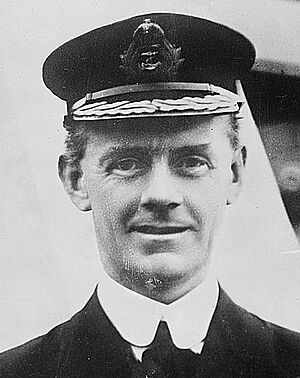Lionel Halsey facts for kids
Quick facts for kids
Admiral Sir
Lionel Halsey
|
|
|---|---|
 |
|
| Born | 26 February 1872 London, England |
| Died | 26 October 1949 (aged 77) England |
| Allegiance | United Kingdom |
| Service/ |
Royal Navy |
| Rank | Admiral |
| Commands held | HM Australian Fleet (1918–19) 2nd Battlecruiser Squadron (1918–19) HMS New Zealand (1912–15) HMS Donegal (1911–12) HMS Powerful (1905–08) |
| Battles/wars | Second Boer War First World War |
| Awards | Knight Grand Cross of the Order of St Michael and St George Knight Grand Cross of the Royal Victorian Order Knight Commander of the Order of the Indian Empire Companion of the Order of the Bath Mentioned in Despatches (3) Officer of the Legion of Honour (France) Order of the Rising Sun, 1st Class (Japan) Navy Distinguished Service Medal (United States) |
Sir Lionel Halsey (born February 26, 1872 – died October 26, 1949) was a brave British Navy officer. He later worked for the Royal Family as a courtier, which means he helped manage royal households. He was known for his long and important career serving his country.
Contents
Lionel Halsey was born in London, England. He was the fourth son of Sir Thomas Frederick Halsey. After going to school at Stubbington House, he joined the Royal Navy in January 1885. He started his career as a sub-lieutenant in 1891.
In 1893, he was promoted to lieutenant. He served on the Royal Yacht Victoria and Albert. He also worked with the British fleet in the Mediterranean Sea and near North America.
Serving in the Boer War
Halsey joined the ship HMS Powerful. During the Second Boer War (1899-1902) in South Africa, he led a group of naval guns. These guns helped defend the town of Ladysmith. For his bravery, he was mentioned in official reports and promoted to commander in 1901.
After the war, he served as the second-in-command on HMS Good Hope. This ship took an important government official, Joseph Chamberlain, on a tour of South Africa.
Becoming a Captain
In 1905, Halsey became a captain. He took command of the ship Powerful again. He then commanded HMS Donegal in 1911.
In 1912, he took charge of a new, powerful warship called the battlecruiser HMS New Zealand. He sailed this ship around the world to show the British flag. During this trip, the Māori people of New Zealand gave him a special Māori piupiu (a traditional war skirt). He famously wore this skirt during naval battles in the First World War.
First World War Service
When the First World War began, Captain Halsey commanded HMS New Zealand. He led his ship in two important battles:
- The Battle of Heligoland in 1914.
- The Battle of Dogger Bank in January 1915.
He was praised for his actions in both battles. During these fights, he wore the Māori piupiu over his uniform. This became a tradition he continued throughout the war.
Working with Admiral Jellicoe
In June 1915, Halsey became the "Captain of the Fleet" for Sir John Jellicoe. Jellicoe was a very important admiral. Halsey served on Jellicoe's flagship, HMS Iron Duke (1912).
He was present at the huge Battle of Jutland in 1916. This was one of the biggest naval battles in history. For his service, he received the Companion of the Order of the Bath (CB) award.
Promotions and Awards
Halsey continued to rise through the ranks. In 1916, he became the Fourth Sea Lord at the Admiralty (the headquarters of the Royal Navy). He then became the Third Sea Lord in 1917. In April 1917, he was promoted to rear admiral.
He received many awards from different countries:
- The Japanese Order of the Rising Sun, Gold and Silver Star in 1917.
- The American Navy Distinguished Service Medal in 1919.
- He was also made a Knight Commander of the Order of St Michael and St George in 1918.
In September 1918, he returned to sea. He commanded the 2nd Battlecruiser Squadron of the Grand Fleet. He was present when the German fleet surrendered at Scapa Flow at the end of the war.
Tour with the Prince of Wales
After the war, from March to August 1919, Halsey worked at the Admiralty again. Then, he became the chief of staff for the Prince of Wales (who later became King Edward VIII). He joined the Prince on a long tour around the world on HMS Renown. They visited Canada, the United States, Australia, New Zealand, and other places. For his work on this tour, he received more honors, including being made a Knight Grand Cross of the Royal Victorian Order (GCVO).
Later Life and Royal Service
In 1920, Halsey became the Comptroller and Treasurer to the Prince of Wales. This meant he managed the Prince's money and household. He was promoted to vice admiral in 1921. He officially retired from the navy in November 1922.
He continued to receive high honors:
- Knight Commander of the Order of the Indian Empire (KCIE) in 1922.
- Knight Grand Cross of the Order of St Michael and St George (GCMG) in 1925.
- He was promoted to full admiral in 1926.
In 1936, Admiral Halsey left his role with King Edward VIII (the former Prince of Wales). This was due to differences of opinion regarding the King's personal life. However, in 1937, he was appointed to a role with the new king, King George VI. He even took part in King George VI's coronation ceremony.
Admiral Sir Lionel Halsey passed away in 1949 at the age of 77. He is buried in the churchyard of St Leonard's church in Old Warden, England.
Images for kids
-
Halsey's grave in the churchyard of St Leonard's church in Old Warden


